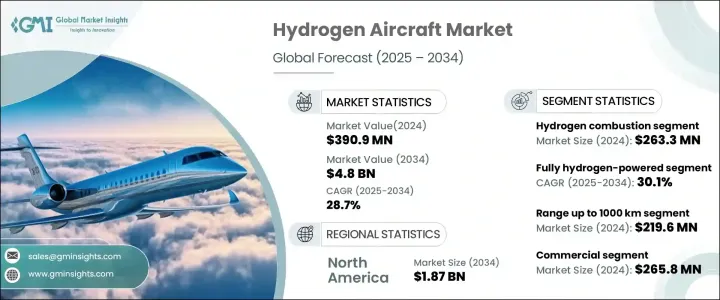
세계의 수소 항공기 시장은 2024년 3억 9,090만 달러로 평가되었으며, 2025년부터 2034년까지 연평균 복합 성장률(CAGR) 28.7%로 성장할 것으로 예측됩니다.
이 확대는 지속 가능한 항공연료의 채용이 증가하고 이산화탄소 배출량의 삭감이 보다 중시되고 있는 것이 배경에 있습니다. 수소를 동력원으로 하는 항공으로의 이행은, 지역 및 단거리 항공편에서 시작되어, 기술의 진보와 함께 궁극적으로 장거리 항공편으로 확대될 것으로 예상됩니다. 연료전지 기술과 수소 연소 엔진에 초점을 맞춘 연구 개발에 대한 투자는 에너지 밀도의 과제를 극복하기 위해 매우 중요합니다.

수소 추진 시스템의 기술적 진보는 항공 산업을 재구성하고 있습니다. 시장은 동력원에 의해 수소 연소와 수소 연료전지로 구분됩니다. 수소 연소 부문은 2024년 2억 6,330만 달러로 평가되었고, 엄격한 배출 규제로 인해 항공사가 보다 깨끗한 추진 기술을 채택해야 하는 것이 성장의 원동력이 되고 있습니다. 수소 연료전지 부문은 대형 항공기용으로 설계된 고성능 연료전지에 대한 투자 증가로, 2025년부터 2034년까지 26.3%로 확대될 것으로 예상됩니다.
| 시장 범위 | |
|---|---|
| 시작 연도 | 2024년 |
| 예측 연도 | 2025-2034년 |
| 시작 금액 | 3억 9,090만 달러 |
| 예측 금액 | 48억 달러 |
| CAGR | 28.7% |
시장은 더욱 기술별로, 완전 수소 동력 항공기와 하이브리드 전기 항공기로 분류됩니다. 완전히 수소를 동력원으로 하는 항공기 분야는 수소 저장과 연료전지의 효율성의 진보에 가세해, 그린 항공을 추진하는 정부의 호의적인 정책에 지지되어 2025년부터 2034년까지 CAGR 30.1%로 예상됩니다.
거리별로 시장은 1,000km 이하, 1,000-2,000km, 2,000km 이상의 3가지 카테고리로 나뉘어져 있습니다. 1,000km 이하 부문은 2024년 시장 규모 2억 1,960만 달러로, 지역편과 단거리편이 이 범위의 수소 엔진 탑재 항공기 수요를 견인하고 있습니다. 항속 거리와 승객 정원을 최적화하도록 조정된 항공기 설계가 이 분야에서의 채용을 가속시키고 있습니다.
여객 정원은 또 하나의 주요 시장 결정 요인으로 4인승, 5-10인승, 10인승 이상으로 구분됩니다.
이 시장은 또 용도별로 민간항공과 군 및 방위항공으로 구분됩니다.
지역별로는 북미가 대폭적인 성장을 이루며 2034년에는 18억 7,000만 달러에 이를 것으로 예상됩니다. 미국의 수소 항공기 시장은 2025년부터 2034년까지 29.1%로 성장할 것으로 예상되며 수소를 동력으로 하는 항공 및 VTOL 시스템에 대한 자금 조달과 투자 증가가 업계의 미래를 형성합니다.
The Global Hydrogen Aircraft Market was valued at USD 390.9 million in 2024 and is projected to grow at a CAGR of 28.7% from 2025 to 2034. This expansion is driven by the increasing adoption of sustainable aviation fuels and a stronger emphasis on reducing carbon emissions. Hydrogen, produced from renewable sources such as wind and solar power, presents a viable, eco-friendly alternative to conventional aviation fuels, significantly lowering the industry's carbon footprint. The transition to hydrogen-powered aviation is expected to begin with regional and short-haul flights, eventually scaling up to long-haul operations as technology advances. Investments in research and development focused on fuel cell technology and hydrogen combustion engines are crucial for overcoming energy density challenges. Strategic partnerships and cross-border collaborations are playing a key role in driving innovation and expediting the integration of hydrogen aircraft into commercial and military fleets.

Technological advancements in hydrogen propulsion systems are reshaping the aviation industry. The market is segmented based on power source into hydrogen combustion and hydrogen fuel cells. The hydrogen combustion segment was valued at USD 263.3 million in 2024, with growth driven by stringent emission regulations compelling airlines to adopt cleaner propulsion technologies. The hydrogen fuel cell segment is anticipated to expand at a CAGR of 26.3% from 2025 to 2034, fueled by increased investment in high-performance fuel cells designed for larger aircraft.
| Market Scope | |
|---|---|
| Start Year | 2024 |
| Forecast Year | 2025-2034 |
| Start Value | $390.9 Million |
| Forecast Value | $4.8 Billion |
| CAGR | 28.7% |
The market is further categorized by technology into fully hydrogen-powered aircraft and hybrid electric aircraft. The fully hydrogen-powered aircraft segment is expected to witness a CAGR of 30.1% from 2025 to 2034, supported by advancements in hydrogen storage and fuel cell efficiency, along with favorable government policies promoting green aviation.
By range, the market is divided into three categories: up to 1,000 km, 1,000 km to 2,000 km, and over 2,000 km. The segment for up to 1,000 km was valued at USD 219.6 million in 2024, with regional and short-haul flights driving demand for hydrogen-powered aircraft in this range. Aircraft design tailored to optimize range and passenger capacity is accelerating adoption in this segment.
Passenger capacity is another key market determinant, with segmentation into up to 4 passengers, 5 to 10 passengers, and more than 10 passengers. The up-to-4-passenger category accounted for USD 87.8 million in 2024, as advancements in hydrogen storage enable greater range and operational efficiency.
The market is also segmented by application into commercial and military & defense aviation. The commercial segment dominated in 2024, valued at USD 265.8 million, as the push for hydrogen-powered commercial aircraft gained momentum. Strategic investments and collaborations in liquid hydrogen technology are fostering innovation in this space.
Regionally, North America is expected to experience substantial growth, reaching USD 1.87 billion by 2034. The presence of major hydrogen aircraft manufacturers and government initiatives aimed at advancing hydrogen propulsion technology are driving regional market expansion. The US hydrogen aircraft market is projected to grow at a CAGR of 29.1% from 2025 to 2034, with increased funding and investment in hydrogen-powered aviation and VTOL systems shaping the industry's future.